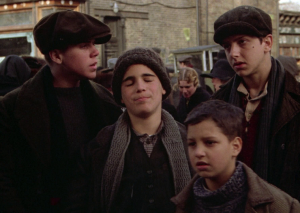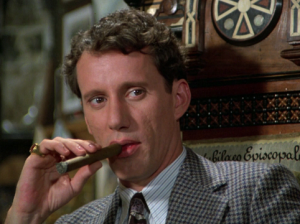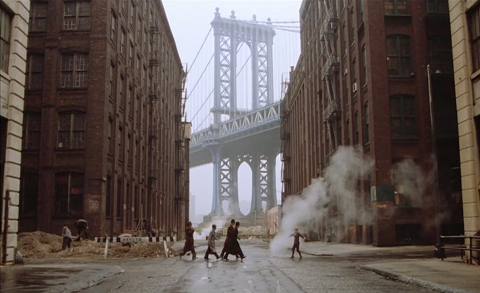Redefining the term epic movie, Italian director Sergio Leone would man the helm of what could be the most masterful pieces of cinematic beauty ever created with the 1984 fictitious gangster piece “Once Upon a Time in America.” With a focus on three distinct points in time, Leone mixes and displays scenes set in 1920, the early 1930s, and 1968 in a neo-style non-chronological order, tying together one gripping story that spans nearly half a century in a single mans life. The result is not only a compelling and action packed mob movie, but a fantastic and historical representation, perhaps the best ever captured on film, of the prohibition era in the United States and the dire complications it would ultimately cause.
There’s nothing more terrifying than mafia thugs hunting for a rat, and that’s exactly how the film opens. Said rat in this case is David Aaronson (Robert De Niro) who goes by the nickname ‘Noodles.’ With his three childhood friends and gang member cronies lying obliterated in the street, Noodles flees New York City in 1933 with unknown assailants on his tail.

The story takes us back to 1920, when New York City was in its infancy, and trench coats and fedoraswere the style. We follow a then teenage Noodles and the formation of his neighborhood street gang out of a poor Jewish slum, which eventually turns into a pack of adult criminals. Based on the 1952 novel The Hoods by Harry Grey, “Once Upon a Time in America” has one of the most phenomenal atmospheres I have ever witnessed on film. With its perfect backdrop and enviable costumes, you’ll feel as though you are watching actual footage of 1920s New York.
There’s something so mesmerizing about the early days of New York City, and this movie manages to harness that lore like no other. Robert De Niro is always a go to guy for the role of mobster, often in a tongue in cheek sort of way. De Niro plays the character of Noodles as well as any role he has ever been in. One scene at the beginning depicts Noodles about to board a bus that will take him away from New York for good. De Niro, a lifelong New Yorker himself, will make you appreciate the pain that would come from such an ordeal. Without uttering a single word, you’ll feel as though De Niro himself were being banished from the Big Apple in disgrace. Joining De Niro is another of my all time favorites – James Woods – who demonstrates his perfect penchant for playing the deplorable as Noodles’ best friend, Max. Awkward and geeky as a teenage hoodlum, Max and Noodles form a lifelong bond that will carry well through adulthood. There’s just something about James Woods as a villain that can make any viewer appreciative of his immense talents.

The brilliance of the story is the shifting of focus between the various points of time in Noodles’ life. Hiding in anonymity for three decades, Noodles receives a sinister letter in which he forensically decodes. “Dear Noodles, even though you’ve been hiding out in the asshole of the world, we found you.” The source of the letter remains a mystery throughout, and as the viewer puts focus on the formation of the gang, you’ll forget that fifty years have passed, and Noodles is still on the run – but from what we don’t know. I found myself smitten with the score of the film as well. The background music hums softly and captures a piece of a time long gone. The addition of the haunting but beautiful melody “Cockeye’s Theme” which plays at various points throughout will send a tingle down your arms. A word to the easily squeamish – this film contains a plethora of excessive carnage and gore, even by mob movie standards.
The story behind the making of the film is almost as epic as the tale itself. Originally an Italian production, Sergio Leone wanted to tell a story for the ages. The original film was close to 6 hours in length, but producers (thankfully) forced the director to shorten it, which he did, down to just under 4 hours. While the story itself is captivating, many scenes overdrawn just a touch, and a bit of snipping in the editing room wouldn’t have hurt. It’s a great epic and perfect depiction of the era, but no matter how good it is, no movie ever needs to be 1/6 of a day long. “Once Upon a Time in America” is a film for film lovers. The setting, the dialogue, and the story are to the genre of cinema as the ceiling of the Sistine Chapel is to lovers of art. Don’t let the 4-hour running time scare you. The casual fan will want to set aside 2 days to watch, due to the sheer length alone, but won’t be disappointed. “Once Upon a Time in America” is an all time great – mob movie, and film in general.
– by Matt Christopher

